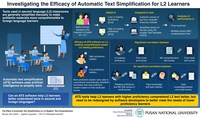New study conducted by Pusan National University finds automatic text simplification (ATS) software for foreign language learners with high reading proficiency
BUSAN, South Korea, Oct. 27, 2022 /PRNewswire/ — Texts used in second language (L2) classrooms have traditionally been simplified manually. With recent technological advances, text can be simplified automatically through artificial intelligence-enabled software. A new study investigated the effectiveness of an automatic text simplification (ATS) software and found that it made text comprehensible for L2 learners with a certain level of reading proficiency, highlighting the need for additional development of these tools for them to become effective for all learners.
For students learning a second or foreign language, text is often simplified to ensure that they can comprehend it well enough to understand the core message. Usually, complicated text in a foreign language is simplified manually by teachers or material designers. However, with the advent of artificial intelligence (AI)-based software, automatic simplification of text is now a reality. One such tool is the automatic text simplification (ATS) software, which simplifies text in second and foreign languages for L2 learners. Currently, there is limited data on the effectiveness of an ATS software in an educational setting.
To address this, Professor Dennis Murphy Odo from the Department of English Education at Pusan National University conducted a study, published in Applied Linguistics, to assess how L2 learners comprehend English language text simplified by an ATS tool. For this purpose, he recruited 61 native Korean speakers who had been studying English for the past 10 years, with reading proficiencies ranging from low to high.
These L2 learners were divided into low and high L2 reading proficiency groups and assigned to read either authentic English text derived from the Scientific American website, or automatically simplified version of that same text using a ‘Yet Another Text Simplifier’ (YATS) ATS tool. Following this, the L2 learners from both groups took a free recall test and a multiple-choice (MC) comprehension test, that tested their ability to recall and comprehend the text.
The key finding, derived from an analysis of the free recall test scores was that L2 learners with a higher reading proficiency found automatically simplified text more comprehensible, as compared to L2 learners with a lower reading proficiency.
While discussing this finding Prof. Odo remarks, “Although online automated text simplification tools can prove to be highly useful in making authentic materials more comprehensible for L2 learners beyond a certain level of foreign language reading proficiency, they may not do so for learners with a lower level of reading proficiency.”
Hence, ATS software can help L2 students with a high reading proficiency understand complicated text, and support teachers in simplifying challenging text for their students.
However, there is a need for ATS tools to be developed further, in order to make text comprehensible enough for L2 learners with low reading proficiencies. “On the positive side, software developers will continue to develop AI-enhanced tools that will make challenging texts more and more comprehensible to foreign language learners with different reading proficiencies,” says Prof. Odo in conclusion.
Reference
DOI: https://doi.org/10.1093/applin/amac057
Title of original paper: The Effect of Automatic Text Simplification on L2 Readers’ Text Comprehension
Journal: Applied Linguistics
Authors: Dennis Murphy Odo
Website: https://www.pusan.ac.kr/eng/Main.do
Media Contact:
Jae-Eun Lee
82 51 510 7928
347471@email4pr.com
SOURCE Pusan National University


